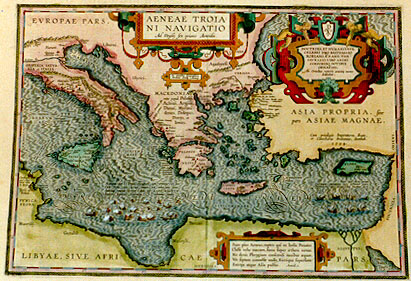Cartographica Neerlandica Background for Ortelius Map No. 223

Title: AENEAE TROIA:|NI NAVIGATIO | "Ad Virgilii sex priores Ćneidos". [The sea journey of Troian Ćneas, after the first six books of the Ćneas by Vergilius]. (Cartouche top right:) DOCTRINA ET HVMANITATE | CELEBRI DŃO BALTHASARO | ROBIANO, R.P. ANT, THE:|SAVRARIO, VIRO ANIMI | CORPORISQ DOTIBVS | ORNATISS. | "Ab. Ortelius veteris amicitić memor | dedicabat". [In memory of his friendship, Abraham Ortelius dedicated this map to the honourable and famous Balthasar Robianus from the republic of Antwerp, known for his learnedness and spiritual and cultural qualities, treasurer and honoured for his physical and mental talents]. (Middle right:) "Cum priuilegio Imperatorio, Regio, | et Cancellarić Brabantić, decennali. | 1594". [With an Imperial, Royal and Council of Brabant privilege for ten years, 1594]. (Lower left:) "Septima post Troić excidium iam vertitur ćstas: | Cum freta, cum terras omnes, tot inhospita saxa, | Syderaque emensć ferimur: dum per MARE MAGNVM | Italiam sequimur fugientem, & volvimur undis". [In the seventh year after the loss of Troy the summer has come to an end; so many straits we have seen, so many lands, such inhospitable rocks, that now we are impressed by the immense stars. We follow fleeing Italy through the large sea, and are tossed around by the waves]. (Cartouche bottom middle right:) "Sum pius Aeneas, raptos qui ex hoste Penates | Claße veho mecum, fama super ćthera notus. | Bis denis Phrygium conscendi navibus ćquor, | Vix septem convulsć undis, Euroque supersunt :|(line added in second state:) "Ipse ignotus, egens, Libyć deserta peragro",(end insertion state 2) | "Europa atque Asia pulsus. Ćneid. 1". [I am Aeneas the dutiful one, and I carry with me the house God has taken from the enemy on my fleet, my fame known in the sky. With twenty ships I sailed the calm Phrygian sea. No more than seven ships including the Euro remain now, (added in state 2:) although not aware of it, poor, I roam the Libyan desert (insert state 2 ends here), pushed by Europa and Asia.] (Bottom right:) "Naves quć fortč paratć | Corripiunt, onerantque auro, portantur avari | Pygmalionis opes pelago, dux femina facti". [The ships which are ready have been assembled, and have received a cargo of gold, and the avaricious men are carried, their strength in the sea of Pygmalion caused by their female leader. (E23)].
Plate size: 347 x 494 mm.
Scale: 1 : 7,500,000
Identification number: Ort 223 (Koeman/Meurer: 32P, Karrow: 1/208, van der Krogt AN: 0311H:31).
Occurrence in Theatrum editions and page number:
1595L5Addblank (100 copies printed) (text and typesetting identical to 1595L, but without page number; last line, centred like the line above it, below pictures of 2 rows of 7 coins: Ćneć nauigationis historiam non parum conducentia.),
1595Lf (500 copies printed) (text and typesetting identical to 1595L5Add, but here with page number f; last line, centred like the line above it, below pictures of 2 rows of 7 coins: Ćneć nauigationis historiam non parum conducentia.),
1597G5Addblank (75 copies printed) (identical to 1602G, but here without a page number; last line, centred like 4 lines above it, in Gothic script like the entire text: wollen.),
1601Lxxxiij (200 copies printed) (9th line from the top, in cursive script, ends: "halicar-" ; last line, centred like on line above it: non parum conducentia,in gratiam studiosorum antiquitatis subiicere placuit.),
1602G31 (250 copies printed) (identical to 1597G5Add, but here with page number; last line, centred like 4 lines above it, in Gothic script like the entire text: wollen.),
1603L rarely xxxiij or usually xxxv (300 copies printed) (text and page number, but not typesetting, identical to 1609/1612L/S xxxiij; 9th line from the top, in cursive script, ends: "tradit" ; last line, centred like one line above it: non parum conducentia,in gratiam studiosorum antiquitatis subiicere placuit.),
1606Exxxiij (300 copies printed) (last line, italic, full width: "It neuer may, I trow, the honest fame distaine, Wherein thou" Dido "long didst liue amongst thine owne, And still of wiser sort thorowout the world is knowne".),
1608/1612Ixxxv (300 copies printed) (last line above Ex argento. & coins, in cursive script, centred like one line above it: "Ma ne anco perde la sua honesta per li falsi versi, Didone,la qual regnando felice viue per li secoli".),
1609/1612Sxxxv (text in Latin) = 1609/1612Lxxxv (600 copies printed) (text and page number, but not typesetting, identical to 1603L; 9th line from the top, in normal script, ends: in ; last line, centred like one line above it: non parum conducentia,in gratiam studiosorum antiquitatis subiicere placuit.),
1624P/1641Sxxxix (1025 copies printed) (last line second column first text page, right aligned, in cursive script: "Talis" ; last line second text page, second column, left aligned: antiquitatis sunijcere placuit.).
Approximate number of copies printed: 3650.
States: 223.1 as described.
223.2: in 1601 the place names "Pallene" and "Aphrodisium" were added on left of Lemnos, and "Nesos" was added on the Peloponnesos;
223.3: after 1612 and before 1624, the bottom cartouche with text from Vergil's Ćneas was removed and re-engraved, now with six in stead of five, lines in new cursive writing (see above).
Cartographic sources: after the destruction of Troy, Ćneas is reported to have roamed the seas for seven years, as described among others in the writings of Xenophon, Ovidius and Lycophron, but most extensively by Vergilius in his Ćneas. In the course of these wanderings, only seven of the original twenty ships remained, as may be seen on this map in the lower left part of the sea.
For questions/comments concerning this page, please e-mail info@orteliusmaps.com.